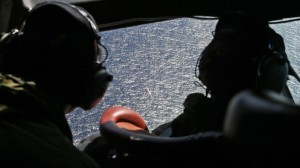Searchers race to find jet; no new signals heard

Wing commander Rob Shearer captain of the Royal New Zealand Air Force P3 Orion left, and Sgt. Sean Donaldson look out the cockpit windows during search operations for missing Malaysia Airlines Flight MH370 in the southern Indian Ocean, near the coast of Western Australia, Friday, April 4, 2014. AP FILE PHOTO
PERTH, Australia – With no new underwater signals detected, the search for the missing Malaysian passenger jet resumed Saturday in a race against time to find its dying black boxes five weeks after families first learned their loved ones never arrived at their destination.
The ocean search area has been condensed, as ships and planes hunted for any clue that could help find Flight 370, which disappeared en route from Kuala Lumpur, Malaysia to Beijing with 239 people on board, mostly Chinese.
Australian Prime Minister Tony Abbott told Chinese President Xi Jinping that he was confident signals heard by an Australian ship towing a U.S. Navy device that detects flight recorder pings are coming from the Boeing 777. Officials believe the plane flew off course for an unknown reason and went down in the southern Indian Ocean off the west coast of Australia.
“We’re getting into the stage where the signal from what we are very confident is the black box is starting to fade,” Abbott told reporters Friday in Shanghai, referring to the plane’s flight data and cockpit recorders. “We are hoping to get as much information as we can before the signal finally expires.”
Search crews are running out of time because the batteries powering the recorders’ locator beacons last only about a month, and that window has already passed. Finding the devices after the batteries fail will be extremely difficult because the water in the area is 4,500 meters (15,000 feet) deep.
Article continues after this advertisementTwo sounds heard a week ago by the Australian ship Ocean Shield, towing the ping locator, were determined to be consistent with the signals emitted from the black boxes. Two more pings were detected in the same general area Tuesday.
Article continues after this advertisement“We are confident that we know the position of the black box flight recorder to within some kilometers,” Abbott said. “But confidence in the approximate position of the black box is not the same as recovering wreckage from almost 4½ kilometers beneath the sea or finally determining all that happened on that flight.”
Abbott told the Chinese leader that the next steps will be a “very long, slow and painstaking process.”
An Australian air force P-3 Orion, which has been dropping sonar buoys into the water near where the Ocean Shield picked up the sounds, detected another possible signal Thursday, but Angus Houston, who is coordinating the search, said in a statement that an initial assessment had determined it was not related to an aircraft black box.
The Ocean Shield continued to search for additional signals, while the Orions were going on with their hunt, Houston said. The underwater search zone is currently a 1,300-square-kilometer (500-square-mile) patch of the seabed, about the size of the city of Los Angeles.
“It is vital to glean as much information as possible while the batteries on the underwater locator beacons may still be active,” Houston said.
The searchers want to pinpoint the exact location of the source of the signals so they can send down a robotic submersible to look for wreckage. A decision to use the sub could be “some days away,” Houston said.
The Bluefin 21 submersible takes six times longer to cover the same area as the ping locator — about six weeks to two months to canvass the current underwater zone.
Complicating matters is the depth of the seabed in that area. The signals are emanating from 4,500 meters (15,000 feet) below the surface, which is the deepest the Bluefin can dive. The search coordination center said it was considering options in case a deeper-diving sub is needed.
The surface area to be searched for floating debris had been narrowed to 41,393 square kilometers (15 982 square miles) of ocean extending from about 2,300 kilometers (1,400 miles) northwest of Perth. Up to 10 planes and 14 ships were searching Saturday.